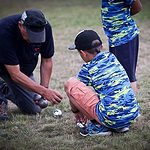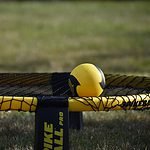A birdie in disc golf occurs when you complete a hole one stroke under par. For example, if you're playing a par-3 hole, finishing it in two throws earns you that birdie. Scoring birdies boosts your overall performance and reputation within the sport, with professional players averaging a birdie rate of 30%-40%. To achieve birdies consistently, you need to employ strategic shot placement, choose the right equipment, and master your throwing techniques. Understanding how to optimize your play can greatly enhance your game. There's always more to explore about improving your birdie count and overall skills.
Key Takeaways
- A birdie in disc golf is achieved by completing a hole in one stroke under par.
- For example, scoring 2 strokes on a par-3 hole results in a birdie.
- Birdies significantly enhance a player's overall score and reputation in the sport.
- The term "birdie" originated from traditional ball golf in the early 1900s.
- Achieving birdies reflects a player's skill, strategic prowess, and understanding of the game.
Understanding Birdies in Disc Golf
In disc golf, understanding what a birdie is can elevate your game remarkably. A birdie occurs when you complete a hole in one stroke under par, showcasing your skill and performance. For instance, if you manage to score a 2 on a par-3 hole, you've achieved a birdie. This accomplishment not only feels rewarding but also contributes notably to your overall score throughout a round.
As you aim for birdies, remember that accumulating these scores can play a vital role in winning competitions or improving your standings among fellow players. The average birdie rate among professional disc golfers hovers between 30% and 40%, indicating that consistent performance is key to competitive success.
Incorporating birdies into your strategy means honing your precision and control with each throw. Every stroke counts, and each time you sink a birdie, you're not just lowering your score; you're also enhancing your reputation within the disc golf community.
Historical Context of Birdies
The historical roots of the term "birdie" trace back to ball golf in the early 1900s, where it was first introduced by Abner Smith after a remarkable shot in 1903 in New Jersey. This term quickly gained traction, becoming a beloved part of golf culture across the U.S.
By the time disc golf began to emerge in the 1920s, particularly with the rise of Tin Lid Golf, the concept of a birdie made its way into this new sport.
In disc golf, achieving a birdie means completing a hole in one stroke under par. This accomplishment not only marks a significant achievement in scoring but also reflects a player's skill and strategy.
As you navigate through the competitive landscape of disc golf tournaments, birdies become essential to your performance. They can influence your overall scoring and determine your standing among competitors.
Understanding the historical context of birdies enriches your appreciation of the game, connecting you to both the origins of ball golf and the evolution of disc golf.
Embracing this knowledge fosters a sense of belonging in a community that values skillful play and competitive spirit.
Strategies for Scoring Birdies
Scoring birdies in disc golf hinges on a blend of strategy and skill, so it's essential to break down each hole's par rating and tailor your approach accordingly. As a disc golf player, understanding that a birdie means scoring one stroke less than par is your starting point.
Focus on your first shot; it sets the stage for your entire hole. Select the best disc for the specific distance and conditions you face.
For your approach shot, strategic shot placement is key. Aim to position your disc as close to the basket as possible to increase your chances of converting that vital putt into a birdie. Practice various throwing styles, like hyzer and anhyzer, to better navigate course layouts and enhance your shot versatility.
Don't overlook course conditions—wind patterns and terrain obstacles can greatly affect your decisions.
Regularly track your performance metrics; knowing your average birdie rate can motivate you to refine your strategies. With dedication and thoughtful planning, you can elevate your game and consistently score those coveted birdies, fostering a deeper sense of belonging within the disc golf community.
Equipment for Achieving Birdies
Achieving birdies demands not just skill but also the right equipment tailored to your playing style and the course's demands. To consistently score under par, you'll want to focus on using fairway drivers, as they offer the controlled distance and precision necessary for maneuvering tricky holes.
If you find yourself facing windy conditions, an overstable disc can greatly enhance your performance, allowing for accurate throws that lead to birdies.
When it comes to maximizing your throws, consider incorporating understable discs into your arsenal. These discs promote longer flights and hyzer-flip shots, which can be invaluable when approaching the basket.
Choosing the right putter is equally essential; the ideal putter makes a world of difference for short-range throws, directly impacting your ability to convert those easy putts for birdies.
Familiarizing yourself with various disc flight characteristics, including speed and glide ratings, will empower you to select the best disc for each course layout.
Whether you're a seasoned player or just starting, having the right equipment can elevate your game and help you achieve those coveted birdies.
Techniques for Competitive Play
While mastering the techniques for competitive play, you'll find that precision and strategy are your best allies in scoring birdies. To achieve that elusive birdie, you must execute your shots with skillful control, completing each hole in one stroke less than par. Consistent practice with various throwing styles, such as backhand and forehand, can greatly enhance your chances.
Effective course management is essential; study hole layouts to identify ideal lines to the basket. This understanding enables you to navigate the course more efficiently and set yourself up for birdies. Knowing the different disc types and their flight ratings helps you select the right disc for each shot, increasing your chances of success.
Focus on executing approach shots with high accuracy, as these are often the key to setting up your putts. In competitive settings, remember that a successful close-range putt can convert a birdie opportunity.
As you refine your skills, you'll develop a deeper connection to the game and a sense of belonging within the disc golf community. Embrace these techniques, and you'll find yourself chasing birdies with newfound confidence.
Conclusion
In disc golf, scoring a birdie isn't just about luck; it's a combination of skill, strategy, and practice. The theory that birdies are purely a product of chance doesn't hold up under scrutiny. With the right techniques and equipment, you can consistently lower your score. As you refine your approach and understand the nuances of the game, those birdies will become more frequent, transforming your play and enhancing your enjoyment of this dynamic sport.





